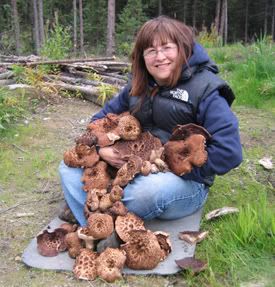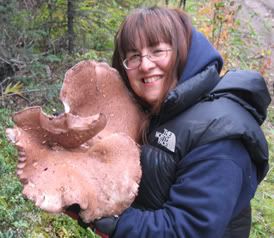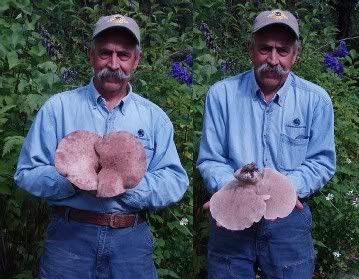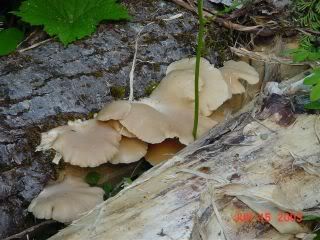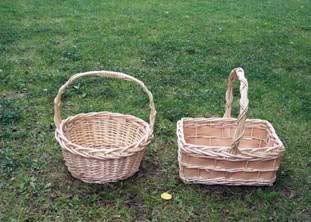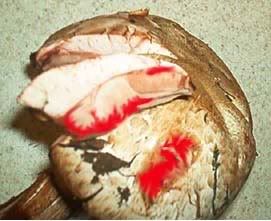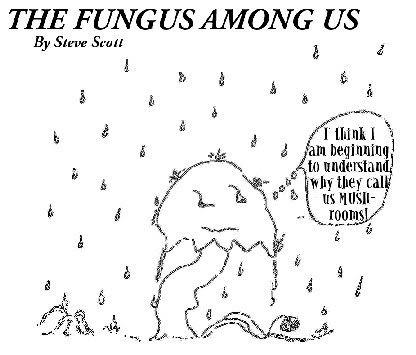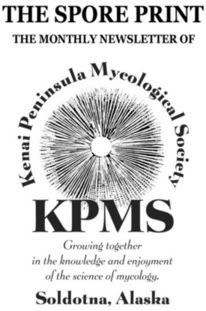Issue 11, October 2006
Our September foray took place almost at the peak of the fruiting season. We met under the covered picnic area at Soldotna Creek Park. The turnout was good, and everyone arrived loaded down with mushrooms. We had scores of specimens and dozens of species to identify. The collection filled two of the tables and spilled over onto a third. Dominique took on the task of separating the mushrooms into groups of related genera and then took each group and identified the individual specimens, commenting on their characteristics, edibility etc., and answering any questions that were asked. We are very fortunate to have some-one with his knowledge among our members.
There is another key element that has made our forays a success. We have a ‘core’ group of a dozen or so dedicated ‘shroomers who can be counted on to show up at every gathering regardless of the time, place, or weather. With their enthusiasm and eagerness to learn, I have no doubt that they will be leading the forays and doing much of the identification and explanation in the years to come.
Since the foray, the fruiting flush has been slowly tapering off, but that doesn’t mean there aren’t fresh mushrooms to be found. This wet fall also offers the opportunity to find species that you may not see again for years, if ever. Don’t let the damp weather stop you from getting out and poking around. You might be surprised what you find!
I had to include this photo of Kathy’s monster ‘hedgehog’.
No, this isn’t a photo of Cliff Cullings and his twin brother. I may have ‘doctored’ up the pic to get both views of his ‘twin hedgehogs’ but that mushroom is the real McCoy!
OUR NEXT MEETING WILL BE ON SATUR-DAY, OCTOBER 7TH, AT 1:00 P.M., IN THE COOK INLET AQUACULTURE BUILDING (40610 K-BEACH ROAD, KENAI).
In addition to our regular meeting, we will set aside some time for a mushroom identification and information session, so bring your specimens!
Confused? So am I. Someone should come out with a reference book just for all the name changes that have occurred for every mushroom species. I’d buy one in a heartbeat!
Last Month’s Mushroom of the Month
We had two responses for last month’s contest. Both were correct. The mushroom pictured above is Pleurotus ostreatus. The prize was a collecting basket for the first respondent, but, as we only had two, we are giving baskets to both.
Melissa Cates and Betty Idleman will both receive baskets. Melissa had the first correct response and will get her choice of the baskets pictured below:
The photo of October’s mushroom of the month was submitted by Ben Keenan. This is a medium sized mushroom with white flesh and red-brown scales on a white cap. It has close, free gills and a chocolate-brown spore print. But, the feature that makes this mushroom unique is the rapid cherry-red staining of the flesh of the cap and top of the stem when it is cut or bruised. (See the photo below.)
If you are the first to respond with the correct answer, you will receive an English China coffee cup bearing an outdoor scene which includes a number of mushrooms. Fill it with steaming hot coffee, pull out your favorite mushroom field guide, and enjoy!
Here is another photo from Ben. Now, this is one man who knows how to build a pizza, and he harvested those mushrooms himself!
We still have a number of copies of Miller’s North American Mushrooms available. We also struck a deal with another publisher to get a deep discount on some great books. Lone Pine Publishing has a couple of excellent mushroom field guides we can offer our members at our cost plus shipping. Both are excellent guides and include many of the species in our area.
Lone Pine Publishing also has several excellent plant books that are applicable for our area. If you are interested in any of these books, let us know. (I won’t list them here. Go to http://www.lonepinepublishing.com/ for their online catalog.) If we have a sufficient response, we will place an order.
One of our goals at KPMS has been to provide our members with quality resources at affordable prices. Some things we have been able to offer free of charge, others at our cost. (It is because we buy in quantity that the publishers give us such a generous discount on our book purchases. And, it is because we have a strong membership base that we have the funds to purchase in quantity without having to first collect the money up front.) In addition to the field guides and identification CD, we hope in the future to make a number of identification keys available for the cost of duplication.
None of this would have been possible had not so many of you been willing to take a chance with KPMS. Thank you for your confidence.
If you are not a member of KPMS, we encourage you to join. The benefits far outweigh the minimal cost.
There are a number of great educational opportunities available through the local Community Schools program this fall. Here is one entry from the brochure.
BEGINNING MUSHROOMING – Acquiring the basic skills necessary to identify mushrooms.
Steve Scott. This is a non-technical course designed to equip the amateur mushroom hunter with the skills necessary to confidently identify their fungal finds using only macroscopic features. The course will also include an over-view of the fungal kingdom and a discussion on mushroom toxins. Tuesdays AND Thursdays, beginning October 3rd and ending October 19th / 6 nights / 7-9pm / Teens and Adults / 6 Min and 12 Max / $15 that goes to Community Schools (Study materials will be provided.)
I never cease to be amazed by the complex relationships that fungi have developed with other organisms. The mycorrhizal relationship (for example) is extremely important in nature. Mycorrhizal fungi have become so dependent upon a particular tree species that they cannot grow without their host. In addition, recent research has shown that trees deprived of this mutual relationship are unable to successfully compete with those that have formed these mycorrhizal bonds.
I found Dr. Berg’s recent article on lichen, published in the Outdoor section of the Peninsula Clarion, particularly fascinating. (Dr. Berg is a frequent contributor to the Peninsula Clarion and his articles are always interesting.) I had not realized that lichen were such complex organisms. Dr. Berg described them as ‘those curious little “plants” that are a mixture of both fungi and algae. The fungi provide the basic physical structure of the lichen, and the algae provide food for the fungi through photosynthesis.’ He went on to describe their relationship as being less mutualistic or symbiotic and ‘more like captive “farming” of the algae’ to the point where ‘filament type algae . . . . . that normally grow as long chains occur only as single cells within a layer of the fungal body of the lichen, just like carefully planted vegetables in a garden.’ Dr. Berg’s article stirred my curiosity and I really wanted to learn more about this fungal-algal relation. Then the latest issue of the Mycophile came in the mail. To my surprise, the lead article was about ‘Lichenomphalias’.
The author, Andrus Voitk, began the article with this statement: ‘Within the genus Omphalina there are two kinds of mushrooms—those that exist as mushrooms alone and those that exist as the fungal component of a lichen’, and he went on to say that all of the ‘lichenized’ Omphalinas ‘share similar DNA that is different from the rest of the genus’.
As a consequence of this DNA study, there is even a proposal to place these ‘lichenized’ Omphalinas into a new and separate genus—Lichenomphalia.
The focus of Mr. Voitk’s article was not the fungal-algal relationship, but rather, those rare cases where ‘both component organisms exist separately as well as in their combined lichenized form’. Such relationships are so rare that although there are ‘thousands of lichens, very few have a basidiomycete as the fungal partner. Only about twenty species are formed with agarics (mushrooms with cap, stem and gills).’ The result is a fungus, an algae, and a true lichen all interdependent upon one another. (And we refer to them as simple life forms!) Sadly, these specialized ‘foursomes’ are so uncommon and found in such inhospitable environments that few of us will ever see one of them.
Well, so much for my ramblings!
I want to thank all those who submitted photos for the newsletter. If you have an interesting ‘mushroom’ photo, story, joke, comic, recipe or what ever, send it my way. We are always looking for material for the Spore Print. I hope to see you on the 7th of October. Bring a few specimens with you, if you can. Until then, happy hunting,
Steve
Note to our readers: Each issue of the Spore Print also contains an instructional insert. For example, the October issue included an identification key for the seventeen species of Agaricus that probably occur in Alaska. These instructional segments are not posted on the website. Anyone wishing to receive the newsletter in it entirety may contact me at sscott@alaska.net and I will add your name to our mailing list and you will receive each newsletter via e-mail.
